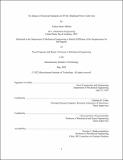The Impact of Electrical Standards on MVDC Shipboard Power Cable Size
Author(s)
Malone, Joshua James
DownloadThesis PDF (8.569Mb)
Advisor
Cooke, Chathan M.
Chryssostomidis, Chryssostomos
Terms of use
Metadata
Show full item recordAbstract
In recent years there has been rising interest in medium voltage direct current (MVDC) power systems for several reasons, including compatibility with DC loads, reduction of induced currents and magnetic signatures, and avoidance of alternating current (AC) frequency synchronization issues when combining outputs from multiple sources [1]. However, few MVDC systems are currently in operation, and little is known in terms of design and test parameters in comparison to the vast wealth of knowledge available for medium voltage alternating current (MVAC) systems. There is currently only one standard governing MVDC applications, the Institute of Electrical and Electronics Engineers (IEEE) Standard 1709, recommendations for shipboard MVDC systems [2].
The goal of this study is to provide recommendations for shipboard MVDC power cable design and test values, and to examine how existing MVAC and MVDC standards affect MVDC cable size. A review of published standards and guidelines for MVAC cable design and test values is made and includes the collection of recommended lightning-impulse Basic Insulation Level (BIL), the short-duration overvoltage Withstand Voltage Test and cable insulation thickness values. The collected MVAC cable design and test values are compared to each other as well as to the sole MVDC standard in order to provide more informed suggested MVDC cable design and test values as well as MVDC cable sizing. It was found that there is a tradeoff with the thickness of cable insulation, where a small reduction in cable system size can be achieved by a reduction in insulation thickness but at a penalty of substantially greater electric stresses within the insulation. The collected results provided a basis for a proposed MVDC cable design process and for example shipboard MVDC cable systems with layouts, rated for 75, 100, and 125 [MW] power levels, and 12 and 18 [kV] Nominal System Voltages.
Date issued
2022-05Department
Massachusetts Institute of Technology. Department of Mechanical EngineeringPublisher
Massachusetts Institute of Technology